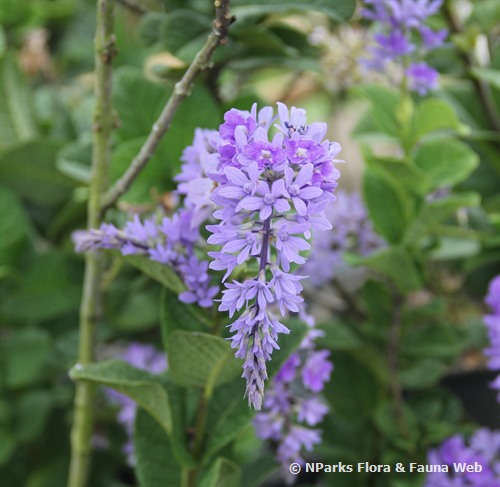
Back
Petrea volubilis
| Family Name: | Verbenaceae |
| Common Name: | Sandpaper Vine, Queen's Wreath, Purple Wreath, Sandpaper |
The Sandpaper Vine (Petrea volubilis) have attractive pale blue to violet, star-shaped flowers which drape down from the woody climber. Although the flowers are short-lived, the secret to its beauty lies in the long lasting petal-like, violet calyces which persist even after the flowers have fallen. The vine’s rough textured leaves resemble sandpaper, giving it the common name Sandpaper Vine.
Name
Classifications and Characteristics
| Plant Division | Angiosperms (Flowering Seed Plants) (Dicotyledon) |
|---|---|
| Plant Growth Form | Climber, Shrub |
| Lifespan (in Singapore) | Perennial |
| Mode of Nutrition | Autotrophic |
Biogeography
| Native Distribution | Tropical America |
|---|---|
| Native Habitat | Terrestrial |
| Local Conservation Status | Non-native (Horticultural / Cultivated Only) |
Description and Ethnobotany
| Growth Form | A woody climber, it has a twining growth form and can grow up to 6m in height with the aid of support. The plant forms a shrub when not supported. |
|---|---|
| Foliage | The evergreen leaves are simple, arranged in whorls and are ovate-elliptic to elliptical in shape. The upper surface of the leaves has a rough texture. |
| Flowers | The flowers are borne on arching racemes, up to 30cm long. The star-shaped flowers are pale blue to violet and have conspicuous, slender calyx lobes which are of a lighter shade as compared to the flowers. The calyx persists on the plant after the flowers have dropped, gradually drying up and turning brown. |
| Similar | Similar to Petrea rugosa. P. rugosa has wrinkled leaves and smaller flowers, with shorter petals and calyces. |
| Etymology | The genus Petrea is named after Robert James Petre , the patron of botany. The specific epithet volubilis means entwinning. |
| Ethnobotanical Uses | Cultural / Religious: According to indigeneous legends, flowers of P. volubilis were said to be used in folk medicine by the Caribs. |
Landscaping Features
| Desirable Plant Features | Ornamental Flowers |
|---|---|
| Landscape Uses | Parks & Gardens, Trellis / Arbour / Pergola |
Plant Care and Propagation
| Light Preference | Semi-Shade, Full Sun |
|---|---|
| Water Preference | Moderate Water |
| Plant Growth Rate | Moderate |
| Rootzone Tolerance | Moist Soils, Well-Drained Soils, Fertile Loamy Soils |
| Propagation Method | Seed, Stem Cutting (Hardwood) |
Foliar
| Foliage Retention | Evergreen |
|---|---|
| Mature Foliage Colour(s) | Green |
| Mature Foliage Texture(s) | Rough |
| Foliar Type | Simple / Unifoliate |
| Foliar Arrangement Along Stem | Whorled |
| Foliar Attachment to Stem | Petiolate |
| Foliar Venation | Pinnate / Net |
| Foliar Margin | Entire - Wavy / Undulate |
Floral (Angiosperm)
| Flower Colour(s) | Purple, Blue |
|---|---|
| Flower Grouping | Cluster / Inflorescence |
| Flower Location | Terminal |
| Flower Symmetry | Radial |
Image Repository
Others
| Master ID | 175 |
|---|---|
| Species ID | 1471 |
| Flora Disclaimer | The information in this website has been compiled from reliable sources, such as reference works on medicinal plants. It is not a substitute for medical advice or treatment and NParks does not purport to provide any medical advice. Readers should always consult his/her physician before using or consuming a plant for medicinal purposes. |




.jpg)






